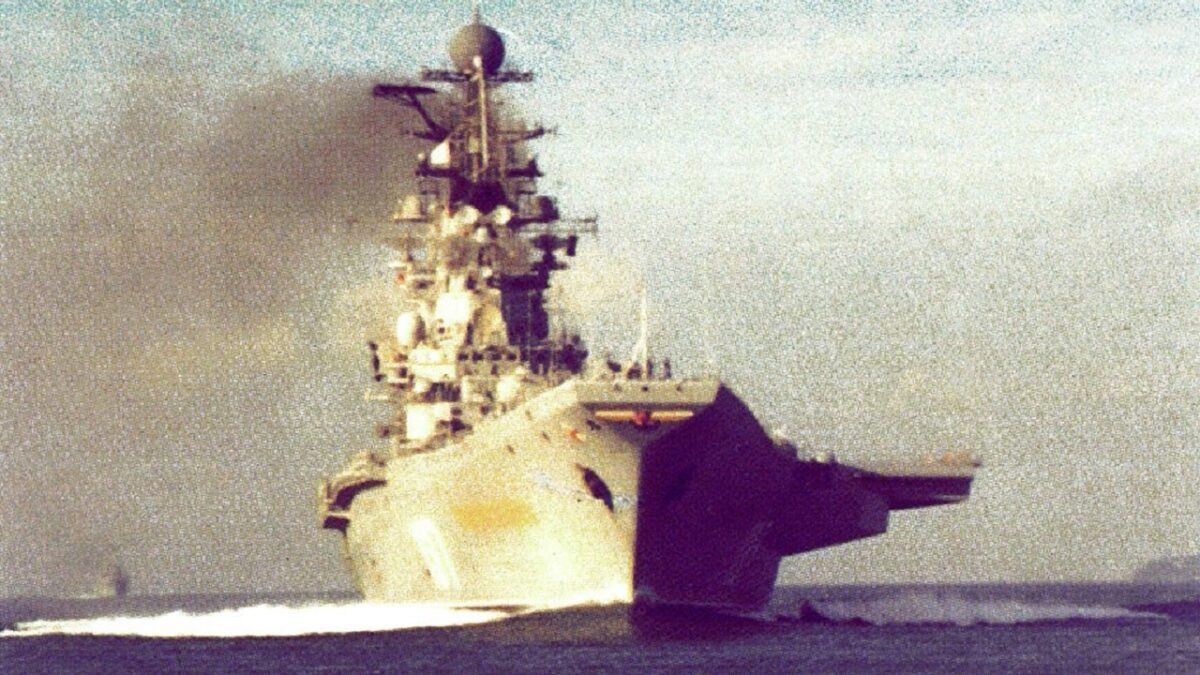It almost makes no sense. Russia is a great power with a lot of military muscle, and yet, Moscow does not have anything close to a large fleet of aircraft carriers like the United States and now China. Why is that? Well, we reached out to an expert to explain to us in the clearest terms why:
Given Russia’s stature as a near-peer competitor of the United States with interests in regions as far afield from Moscow as Latin America and Africa, one might expect that the Russian navy would have sea power tools similar to that of the United States to project power in support of those interests. While China’s People’s Liberation Army Navy has just launched its aircraft carrier on June 17, Russia’s shipbuilding queue is notably devoid of concrete plans to build any more carriers, even if the idea has been periodically floated.
Russia’s Navy is unlikely to acquire new aircraft carriers for the foreseeable future as a result of financial pressures, prioritization of other projects by Moscow, and Russia’s long history as a land power.
Soviet Plans for a Large Navy
Despite Moscow’s plans to build a sizeable fleet of aircraft carriers in the twilight years of the Soviet Union, this never came to pass. The Soviet Union’s first foray into the field of sea-based aviation was the Moskva-class helicopter carriers, of which two examples were eventually completed in 1967 and 1969 respectively. However, it wasn’t until the Kiev- and Kuznetsov-class “heavy aviation cruisers” (as they were classified by the Soviet Navy to facilitate their transfer out of the Black Sea as the Montreux Convention) were developed that the Soviet Union would truly try its hand at creating an aircraft carrier fleet capable of carrying fixed-wing aircraft.
The Soviet Union built four Kiev-class carriers between 1972 and 1987. These ships tried to take on two conflicting roles at once – that of a carrier and that of a cruiser. All of the Soviet Union’s Kiev-class carrier-cruiser fusions were inherited by Russia after the collapse of the Soviet Union but were sold off one-by-one to foreign buyers or scrappers as they were too costly for the struggling Russian government to maintain and were also cut off from the shipyard that built them in what is now the Ukrainian city of Mykolaiv.
Only two examples of the Kuznetsov carrier-class were completed by the collapse of the Soviet Union, one of which – the Admiral Kuznetsov itself – is the only aircraft carrier in Russian service today, while the other was sold off to China in disrepair in the early post-Soviet era.
The Soviets also attempted to build their own class of huge nuclear-powered carriers in an effort to match those of the United States. However, this would not be, as the Ulyanovsk, the first and only ship in the class to be laid down before the collapse of the Soviet Union, was scrapped in 1992.
The Admiral Kuznetsov in Today’s Russian Navy
Given the state of Russia’s only remaining aircraft carrier, it is hard to believe that the Russian state can (or is willing to) shoulder the costs to build and maintain even one additional carrier. Deficiencies in its power plant cause frequent breakdowns as well as significant accidents in 2018 and 2019 which occurred while the Admiral Kuznetsov was in drydock and left the ship heavily damaged have both extended the ship’s refit timeline and potentially added billions of dollars to the project’s price tag.
However, all recent signals from Moscow indicate that Russia is continuing to entertain the possibility of building a new aircraft carrier. In an interview with Interfax, Andrei Elchaninov, the First Deputy Chairman of the Collegium of Russia’s Military-Industrial Commission said that the commission was analyzing whether there was a need for a new carrier as well as the potential technical elements of such a project.
However, systemic problems such as high-level corruption and substantial financial and technological sanctions imposed on Russia’s shipbuilding industry after Russia’s February 2022 invasion of Ukraine would certainly slow or hamper any attempt to build a new carrier. It is unclear how much funding has been allocated to the project (if any at all), raising further questions about its feasibility.
The Russian Navy Struggles to Sustain Itself
Russia’s unlikeliness to build an aircraft carrier is a detail in the Russian Navy’s wider struggle to secure the resources it wants in competition with other branches of the Russian Armed Forces. While Russia’s navy is far more capable than it was twenty years ago and can draw upon high-quality shipbuilding competencies within the state-run shipbuilding industry conglomerate, the United Shipbuilding Corporation, the actual number of ships in the Russian navy will likely remain stagnant for the near-term future, save for possible limited expansion by the end of the decade.

A bow view of a Soviet Kiev class aircraft carrier (CVHG) underway
In the years between Russia’s 2014 seizure of Crimea and invasion of eastern Ukraine, the navy has increasingly struggled to fight off competition from Russia’s Ground Forces and advocates of modernizing Russia’s nuclear arsenal, and has steadily lost funding to them accordingly. This is in keeping with the long arc of Russian military history, where naval power has always been a secondary element of the Russian military, whether in Tsarist, Soviet, or modern Russian times.
Even if the Soviet Union had followed through with all of its plans to build a larger carrier fleet, the significant cost to the post-collapse Russian Navy would likely be more than it could afford, leading to similar downsizing to what happened in reality. So long as Russia is a major land power, it will struggle to follow through on aircraft carrier and other projects which have their use in blue-water navies.

